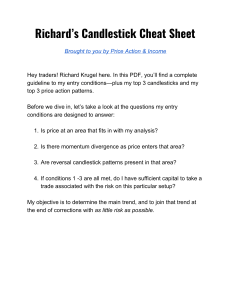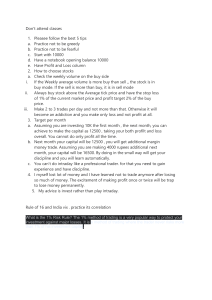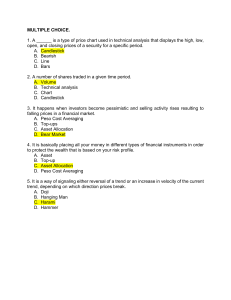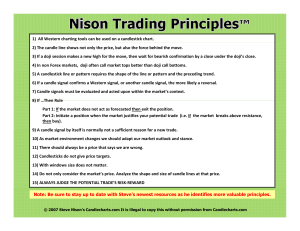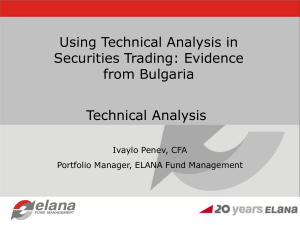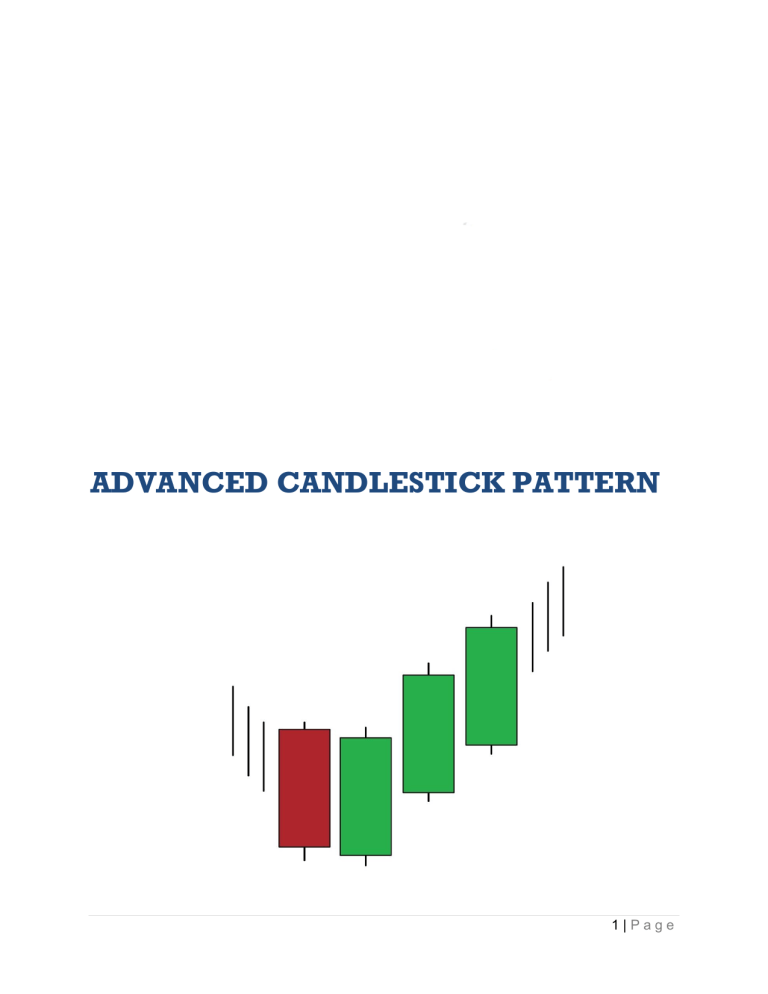
ADVANCED CANDLESTICK PATTERN 1|Page ADVANCED CANDLESTICK PATTERN For some, starting Trading can seem like confusing and a daunting task at first. Confusing zig-zag lines with strange indicators with red and green blocks on them, a number of lines of monitors and charts, wouldn’t seem to make sense to the layman or put better - to someone who doesn't have an understanding of Candlesticks. But some might find it intriguing, exciting and challenging. Candlestick Trading Patterns play a key role in quantitative trading strategies owing to the various notable features of the candlesticks and the variety of Candlestick Patterns present today This e book will help you gain an understanding of Candlesticks and how to use them, to read candlesticks charts, and to interpret candlestick patterns. To gain a complete understanding of Candlesticks, let us begin with the basics. Every new beginner has this Questions in his mind regarding to candlestick…. • What is a candlestick? • What are candlestick patterns? • How to read candlestick chart? • What are the best trading patterns? What are candlestick trading signals? etc. ● What is a candlestick? ● What are candlestick patterns? ● How to read candlestick chart? ● What are the best trading patterns? ● What are candlestick trading signals? etc. ● We cover most of the content and questions related to Candlesticks in this article, which brings us to our next question. 2|Page What Are Candlesticks? Candlesticks (also known as Candlestick charts) are a style of financial chart used to describe high, low, opening and closing price movements of a security, derivative, or currency for a specific period. It resembles the shape of a candlestick and thus the name. So, what makes them so special, won’t there be certain qualities associated with it? But of course! Qualities Of Japanese Candlesticks Their qualities can be listed as: ● Dense ● Packed with information ● Indicate Market Psychology, and the emotions of buyers and sellers ● Represent trading patterns over a short period of time ● Sometimes, few days or few sessions are required ● Can be used in the technical analysis of currency price patterns and of equities ● Can be used for any Forex time frame Candlestick charts are also called Japanese Candlestick Charts. Can you guess where it got its name from? This brings us to our next question. Why Are Japanese Candlesticks Called So? Candlesticks are thought to have been developed in 17th century Japan, and thus they are called Japanese Candlesticks. Are you wondering? 3|Page How Did Japanese Candlesticks Originate? Munehisa Homma, a renowned rice merchant from the Japanese town of Sakata traded in Dojima market in the 1700s. Further study of Candlesticks mentions ‘Sakata’s Methods’ or ‘Sakata’s Rules’, that are based on the name of this particular market. Homma is said to have developed candlestick charts during in his lifetime by studying years of historical data and comparing them with weather conditions across the years which also helped him understand the role of emotions on the value and pricing on the trade of rice. He was known for having practised financial instruments at that time. But then, wouldn’t there be some story behind Candlesticks present globally and how word spread about it? So, we ask this: What Is the History of Japanese Candlesticks? Post their invention, 17th century people from Japan started using Candlesticks while trading rice. This idea proliferated through various people and across countries, getting modified, getting refined and evolved into its present form today. Japanese Candlesticks are thought to have been introduced to the West in the book, ‘Japanese Candlestick Charting Techniques’ by Steve Nison. The West developed the bar point and figure analysis almost a 100 years later. In ancient Japan, the principles were applicable to Rice and today they are applicable to stocks. This brings us to the topic at hand: 4|Page Modern Day Japanese Candlesticks Modern Day candlesticks have maintained the integrity, anatomy and meaning behind them with the changing times. Their meanings have stayed the same which is reflected in some candlestick patterns today as well, as you'll see in the post below. Just to give you an idea of how it would look, I’ll use a sample of State Bank of India to show its Candlestick Patterns during a single Day. Three white soldier’s candlestick patterns Three white soldiers are a bullish candlestick pattern that is used to predict the reversal of the current downtrend in a pricing chart. The pattern consists of three consecutive long-bodied candlesticks that open 5|Page within the previous candle's real body and a close that exceeds the previous candle's high. Hook Reversal Pattern /Hook bullish Pattern Hook Reversal Pattern are short- to medium-term reversal patterns. They are identified by a higher low and a lower high compared with the previous day. Here are bullish and bearish examples of the patterns. ENTRYOn the bullish pattern, there is downtrend, followed by two up days. The first or second up day breaks the high of the last down day. It is the second up day when a long trade should be taken, as the pattern indicates that the price could continue to rally. 6|Page EXITKnow your exit points before trading this pattern. In most cases, you will see a sharp reversal, as shown in the chart above. Anything to the contrary indicates that the pattern is not working, so exit immediately. Therefore, a stop-loss can be placed below the recent low for the bullish pattern. We can't know how long the reversal will last based on the pattern alone. Therefore, maintain the trade for as long as the price is moving in the expected direction. When the move weakens or a pattern in the opposite direction occurs, take your profit. HOOK BEARISH PATTERN Hook reversal patterns can be either bullish or bearish reversal patterns: Bearish hook reversals occur at the top of an uptrend when the open of the second candle is near the high of the first candle and the close of the second candle is near the low of the first candle. 7|Page ENTRY the bearish pattern, there is an uptrend, followed by two down days, and either the first or second down day breaks the low of the last up day. It is the second down day on which a short trade should be taken, as the pattern indicates the price could slide lower. EXITKnow your exit points before trading this pattern. In most cases, you will see a sharp reversal, as shown in the chart above. Anything to the contrary indicates that the pattern is not working, so exit immediately. Therefore, a stop-loss can be placed above the recent high for a bearish pattern, . We can't know how long the reversal will last based on the pattern alone. Therefore, maintain the trade for as long as the price is moving in the expected direction. When the move weakens or a pattern in the opposite direction occurs, take your profit. 8|Page San-Ku (Three Gaps) Pattern The San-ku pattern is an anticipatory trend reversal signal. The pattern does not indicate an exact point of reversal. Rather, it indicates that a reversal is likely to occur in the near future. The pattern is created by three trading sessions in a row with gaps in between. While each candle doesn't necessarily have to be large, usually at least two or three of the candles are. Here is a three gaps pattern that signaled the end of an uptrend. The price is accelerating higher. There are three gaps higher in a row. Since such momentum can't last forever, the buyers are eventually exhausted and price moves the other way. 9|Page ENTRY This pattern operates on the premise that the price is likely to retreat after a sharp move because traders will start taking profits. For additional evidence of the possibility of a reversal, look for extremes in the relative strength index (RSI) or await a crossover of the moving average convergence divergence (MACD). EXIT This pattern anticipates a reversal. If it doesn't happen, get out of any trade that was taken because of this pattern. Price must follow through in the anticipated direction in order for the signal to be valid. Stop-loss orders can be placed above the high of the pattern if going short. Ride the downward momentum while it lasts. Since it is unknown how long the sell-off will last, take profits when you see a reversal signal in the opposite direction or when the selling momentum slows. Kicker Pattern The kicker pattern is one of the strongest and most reliable candlestick patterns. It is characterized by a very sharp reversal in price during the span of two candlesticks. In this example, the price is moving lower, and then the trend is reversed by a gap and large candle in the opposite direction. The first large green candle is the kicker candle. The second strong green candle shows the follow through of the powerful pattern and helps confirm that a reversal is in place. 10 | P a g e ENTRYThis kind of price action tells you that one group of traders has overpowered the other and that a new trend is being established. Ideally, you should look for a gap between the first and second candles, along with high volume. Enter near the close of the kicker candle (first green candle in chart above) or near the open of the second candle. EXIT Place a stop-loss below the low of the kicker candle. Because kicker candles can be so large, this may mean your stop-loss is a sizable distance away from your entry point. As for a target, this pattern often results in a strong trend change, which means that traders can ride the momentum of the kicker for a short-term trade, or even potentially 11 | P a g e medium-term one, as the price could continue in the direction for some time. THE BOTTOM LINE These advanced candlesticks are associated with strong price moves, and often gaps, which cause sharp shifts in direction. Traders can participate by noticing these patterns and acting quickly to get in as the price moves in the new direction. Candlestick patterns do not have price targets, which means traders shouldn't get greedy. Ride the momentum for as long as it lasts, but get out if signs of trouble occur. Utilize stop-loss orders or a trailing stop-loss. 12 | P a g e
